Pengguna:BukanTeamBiasa/Kotak pasir/Penguatkuasaan undang-undang di Jerman
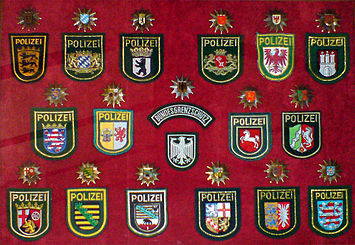
Penguatkuasaan undang-undang di Jerman secara perlembagaan hanya terletak pada negara-negara, yang merupakan salah satu ciri utama sistem politik Jerman.
Polis sentiasa menjadi tanggungjawab negara-negara Jerman walaupun selepas 1871 ketika negara bersatu. Perlembagaan Republik Republik Weimar 1919 telah menyediakan kemungkinan untuk mewujudkan sebuah pasukan polis kebangsaan, sekiranya keperluan itu timbul, tetapi ia hanya dalam era Nazi Jerman bahawa pasukan polis bersatu di bawah kawalan pusat dan pasukan polis kebangsaan diwujudkan (Reichssicherheitshauptamt atau RSHA). Polis menjadi alat negara berpusat dan parti Nazi. Berikutan kekalahan pada tahun 1945, Jerman dibahagikan; pada tahun 1949, ketiga-tiga zon-zon barat telah diubah menjadi Jerman Barat, zonSoviet menjadi Jerman Timur. Setiap negara mengejar laluan yang berbeza mengenai penguatkuasaan undang-undang.
Mengikut penyalahgunaan kuasa kasar oleh negara Nazi berpusat, undang-undang baru Perlembagaan Jerman Barat memberikan pemisahan kuasa yang ketat, meletakkan penguatkuasaan undang-undang dengan kuat di tangan negeri-negeri. Satu-satunya agensi polis yang dibenarkan di peringkat persekutuan adalah pasukan paramiliter Pengawal Perbatasan Persekutuan (Bahasa Jerman: Bundesgrenzschutz), juga bertanggungjawab untuk perkhidmatan pengawal dan Polis Jenayah Persekutuan, kedua-duanya di bawah pengawasan Kementerian Persekutuan Dalam Negeri. Oleh kerana sempadan Jerman menjadi sebahagian besarnya dibuka sejak tahun 2005, disebabkan oleh pembangunan Kesatuan Eropah dan Perjanjian Schengen ke semua negara kejiranan, Bundesgrenzschutz telah ditukar nama kepada Polis Persekutuan (Bahasa Jerman: Bundespolizei). Kewajipan Polis Persekutuan masih terhad kepada keselamatan landasan kereta api, stesen kereta api utama, lapangan terbang, pelabuhan laut, dan beberapa tugas khas lain.
Jerman Timur mencipta pasukan polis berpusat di bawah Kementerian Dalam Negeri, yang Volkspolizei (secara harfiah "Polis Rakyat"). Ia juga menubuhkan pasukan tentera Pasukan sempadan Republik Demokratik Jerman (Jerman: Grenztruppen der DDR), pada mulanya sebuah pasukan bebas, kemudian diintegrasikan ke dalam tentera dan kemudian disusun semula sebagai organisasi tentera yang bebas.
Agensi persekutuan[sunting | sunting sumber]
Pejabat Penyiasatan Jenayah Persekutuan[sunting | sunting sumber]
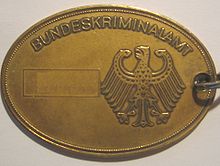
Satu lagi agensi polis pusat, Pejabat Polis Jenayah Persekutuan (Bahasa Jerman: Bundeskriminalamt / BKA), dengan kira-kira 3,000 ejen, beroperasi di seluruh negara dari ibu pejabat di Wiesbaden. BKA adalah rumah penjelasan untuk rekod perisikan jenayah.
Ia memberikan bantuan kepada Pejabat Polis Jenayah Negara Pejabat Polis Jenayah Negara (Bahasa Jerman: Landeskriminalamt / LKA) dalam perkara-perkara forensik, penyelidikan, dan penyiasatan jenayah. Ia juga merupakan titik hubungan nasional untuk Pertubuhan Polis Jenayah Antarabangsa (Interpol). BKA memasuki kes-kes hanya apabila diminta oleh pihak berkuasa negeri, atau dalam kes-kes yang melibatkan dua atau lebih negara. BKA terlibat dalam memerangi pelbagai kumpulan pengganas, yang telah melanda negara sejak 1960-an.

Perkhidmatan Kastam Persekutuan[sunting | sunting sumber]
Perkhidmatan Kastam Persekutuan (Bahasa Jerman: Bundeszollverwaltung) adalah agensi pentadbiran dan fiskal Kementerian Kewangan Persekutuan. Ia ditubuhkan pada tahun 1949 di Jerman Barat. Tujuan Perkhidmatan Kastam adalah untuk mentadbir cukai persekutuan, melaksanakan tuntutan pembayaran bagi pihak syarikat persekutuan dan persekutuan undang-undang persekutuan, memantau pergerakan silang sempadan barangan berkenaan dengan pematuhan larangan dan larangan, dan mencegah kerja haram. Untuk pelaksanaan undang-undang kewangan ejen persekutuan seragam. Subordinat kepada kastam kastam persekutuan, Jabatan Penyiasatan Kastam di Cologne (Bahasa Jerman: Zollkriminalamt / ZKA) menyelaras penyelidikan kastam di seluruh negara khususnya pemantauan perdagangan asing, mengungkap pelanggaran peraturan pasar EU , eksport teknologi haram, penipuan subsidi dalam sektor pertanian, pengedaran dadah dan pengubahan wang haram. Sebagai tindak balas terhadap peningkatan keganasan terhadap pegawai penguatkuasa undang-undang, pasukan kastam SWAT, Zentrale Unterstützungsgruppe Zoll, Kumpulan Sokongan Kastam Tengah (Bahasa Jerman: Zentrale Unterstützungsgruppe Zoll / ZUZ) telah dilaksanakan pada tahun 1997 sebagai taktik kastam unit untuk misi berbahaya.
Perkhidmatan Perisikan Persekutuan[sunting | sunting sumber]
Perkhidmatan Perisikan Persekutuan (Bahasa Jerman: Bundesnachrichtendienst / BND) berpusat di Munich. BND adalah terhad kepada penyiasatan ancaman yang berasal dari luar Jerman. Ia amat bergantung pada teknik pengawasan wiretapping dan lain-lain yang digunakan untuk komunikasi antarabangsa. Kegiatan semacam itu hanya diberi kuasa untuk menentang bahaya ancaman bersenjata ke negara ini, tetapi pihak kepolisian telah menekankan untuk menambah kekuatan untuk memonitor penyelidik senjata dan narkoba internasional yang disyaki.
Pejabat Persekutuan untuk Perlindungan Perlembagaan[sunting | sunting sumber]
(Pejabat Persekutuan untuk Perlindungan Perlembagaan (Bahasa Jerman: Bundesamt für Verfassungsschutz / BfV) terutamanya perkhidmatan perisikan domestik Jerman, yang terlibat dengan pengintipan, pengkhianatan dan hasutan. tiada kuasa penangkapan dan tidak boleh menggunakan kekerasan, tetapi ia menjalankan pengawasan dan membekalkan BKA dan agensi-agensi polis lain dengan maklumat tentang jenayah antarabangsa, pengedaran dadah, keganasan, dan kegiatan haram yang lain, pejabat utamanya di Cologne. di setiap negeri, walaupun mereka bekerjasama rapat dengan pejabat persekutuan, mereka beroperasi di bawah kawalan pihak berkuasa negeri.

Polis Persekutuan[sunting | sunting sumber]
Ditubuhkan pada tahun 1951, Bundespolizei (BPOL) adalah pasukan polis persekutuan yang berseragam. Ia ditundukkan kepada Kementerian Persekutuan Dalam Negeri (Bundesministerium des Innern (BMI)).[1] Bundespolizei sebelum ini dikenali sebagai Bundesgrenzschutz (BGS) ("Pengawal Perbatasan Persekutuan") dan mempunyai peranan yang lebih terhad sehingga 1 Julai 2005 apabila undang-undang yang menamakan BGS sebagai BPOL telah digubal.
Semua kakitangan yang bertugas memakai senjata sisi. Sesetengah unit mempunyai pesawat ringan dan helikopter untuk memudahkan akses pantas ke kawasan sempadan jarak jauh dan untuk misi rondaan dan penyelamatan. Pasukan pengawal pantai membentuk sebahagian daripada BPOL. Ia dilengkapi dengan 14 kren rondaan dan beberapa helikopter.
Di samping mengawal sempadan Jerman, BPOL bertindak sebagai pasukan simpanan persekutuan untuk menangani gangguan besar dan kecemasan lain di luar skop polis Tanah. BPOL menjaga lapangan terbang dan kedutaan asing, dan beberapa detasmen yang terlatih disediakan untuk situasi krisis khas yang memerlukan peralatan perobohan, helikopter, atau kenderaan tempur. Selepas kekurangan dalam prosedur dan latihan polis diturunkan oleh serangan serangan pengganas ke atas atlet Israel pada Olimpik 1972, pasukan petugas yang dikenali sebagai Kumpulan Pengawal Border 9 (GSG- 9) ditubuhkan untuk menangani kejadian pengganas, terutamanya situasi tebusan. GSG-9 memenangi perhatian dunia apabila menyelamatkan 86 penumpang pada pesawat Lufthansa dirampas ke Mogadishu, Somalia, pada tahun 1977.
Struktur pangkat ketenteraan yang serupa dengan Bundeswehr digantikan pada pertengahan 1970-an oleh gred kakitangan jenis perkhidmatan awam. Pakaian seragam itu hijau tetapi telah diubah menjadi biru.
Polis Keretapi Jerman Barat (Bahnpolizei), dahulunya merupakan pasukan bebas, dan Transportpolizei Jerman Timur telah disusun semula di bawah BGS untuk membentuk Bundespolizei pada tahun 1990.
State agencies[sunting | sunting sumber]
State Criminal Investigation Office[sunting | sunting sumber]

The State Criminal Police Office (German: Landeskriminalamt / LKA), is an independent law enforcement agency in most German states, that is directly subordinated to the respective state ministry of the interior. The LKA supervises police operations aimed at preventing and investigating criminal offences and coordinates investigations of serious crime, involving more than one regional headquarter. They can take over investigative responsibility in cases of serious crime, e.g. drug trafficking, organized crime, environmental and white-collar crime or extremist and terrorist offences. Each Landeskriminalamt is also a modern central office for information, analyzing police intelligence from home and abroad and transmitting it to police stations. It collates data on criminal offences and offenders in crime statistics that are used as a basis for new strategies, policy decisions and legislative initiatives. It also analyzes certain offense areas, evaluates the police measures executed in each case, forecasts expected tendencies and describes events in annual reports.
State Offices for the Protection of the Constitution[sunting | sunting sumber]
The State Office for the Protection of the Constitution (German: Landesamt für Verfassungsschutz / lfV) in every single state, is the domestic intelligence service, concerned with espionage, treason, and sedition. Due to the negative experiences of abuseing power in Nazi-Germany, the domestic intelligence duties are not centralized and therefore maintained by the states. As the BfV, the LfV have no powers of arrest and cannot use force, but it carries out surveillance and supplies police agencies with information on opposition parties, international crime, drug trafficking, terrorism, and other illegal activities.
State Police Forces[sunting | sunting sumber]

The German states are responsible for managing the bulk of Germany's police forces.[2] Each state has its own police force known as the State Police (German: Landespolizei). Each state promulgates a law which lays down the organisation and duties of its police (Landespolizeigesetz or Sicherheits- und Ordnungsgesetz).
Although the state police forces are regulated by sixteen different legislatures and are, in fact, different police forces, there has been an increasing tendency toward standardization of police activities nationwide. Concerns about terrorism and the growth of organized crime have strengthened the movement to centralize police procedures and operations. The idea of creating one single police code for the whole of Germany (allgemeines Polizeigesetz) came up in the 1960s but never passed.
These forces are organized by cities, towns, or rural communities, but all are integral components of the police forces of the state in which they are located. The respective state minister of interior supervises police operations in his or her jurisdiction. Although the internal organizations differ somewhat, all state police are divided into the Protective Police (German: Schutzpolizei / SchuPo), a uniformed service carrying out routine law and order duties, and Criminal Police Office (German: Kriminalpolizei / almost always abbreviated with KriPo), who carry out criminal investigations. The separate Administrative Police formerly had duties that included the registration of residents and the issuance of passports, identity cards, and various permits. These functions have been transferred to civil state government departments (Einwohnermeldeamt—Resident registration office) in all states.
The uniforms and vehicle colour schemes of the state police forces are different, but somewhat similar all over Germany, the state police forces are structured differently in each state as well. For example, in some states the Kripo can be part of the ordinary police force, in some states it is organized separately.
The idea of using the same colour for police uniforms and vehicles throughout the European Union has been realized in all German state police forces and the federal police. All vehicle liveries and uniforms changed from white/green to silver/blue until 2018. The basic silver colour for vehicles in the most states, is actually increasing the resale value and thus lowers leasing costs. The uniforms already have been changed by all state police forces and the federal police from the green/beige version introduced in 1979 to blue ones. Hamburg was the first state to make the transition, Bavaria the last state, finishing the replacement of the green/beige uniforms in 2018.
Auxiliary State Police Forces[sunting | sunting sumber]
Some German states maintain auxiliary police forces under different denominations, depending on the state's legislation. In the most auxiliary forces, the officers are armed with pepper spray, in some forces with the regular equipment of professional police officers. Following states maintain a "Voluntary Police Service" (German: Freiwilliger Polizeidienst) like Baden-Württemberg and Hesse, some a "Security Watch" (German: Sicherheitswacht), like Bavaria and Saxony, and only Brandenburg offers a "Security Partner" (German: Sicherheitspartner) program.
Their main duty is crime prevention by:
- conducting walking patrols to deter street crime
- patrolling near schools and kindergartens
- maintaining contact with potential victims of crime and juvenile delinquents.
Bavaria has instituted a system of citizen patrols (Sicherheitswacht) in which unarmed teams of two volunteers patrol assigned areas to improve subjective security. These teams carry a radio to call for help if necessary and a pepper spray for protection. A white armband with black letters identifying them as a "Security Watch" patrol.
Citizens in Baden-Württemberg can participate in the volunteer police programme, where roughly 1,200 citizens voluntarily assist their local police in 20 towns. These volunteers are specially trained, wear regular uniforms and are sworn and armed with normal police gear.
Citizens in Hesse and Saxony can also participate in a Volunteer Police program, where some citizens voluntarily assist their local police. The volunteers are trained for 50 hours in Hesse and 60 hours in Saxony, receive uniforms, pepper spray and a mobile phone in Hesse and a radio in Saxony.
In Brandenburg there were established about 200 security partners along the Polish border as well as around Geater Berlin. The legal basis is a decree of the State Minister of the Interior of 11 October 1995.
People can also join on a full-time basis the Wachpolizei, which has less authority (and less pay) than regular police officers to perform basic police tasks, like the guarding of premisses like an embassy, to release regular officers for patrol work.
Local agencies[sunting | sunting sumber]
Municipal order enforcement agencies[sunting | sunting sumber]
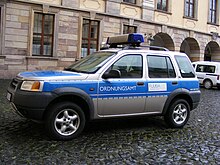
In Germany municipal code enforcement is organized very heterogeneously, depending on state, county and municipal regulations. Currently, many cities in Germany maintain local order enforcement agencies, with limited police-type duties. Those bylaw enforcement officers in general are city employees. Contingent on the respective unit, the officers wear - usually police like - uniforms or wear plain clothes with an armband or a labeled jacket, they could be armed or unarmed. The order enforcement officers are the municipal administration's "eyes and ears on the street". Mostly they are charged with monitoring municipal by-laws and laws that fall under the responsibility of municipalities, which include monitoring the conduct of shop owners, sanitation inspections, veterinary inspections and minor infractions and misdemeanors such as illegal parking, littering, state and local dog regulations etc. They usually only hand out warnings and fines and can only perform a citizen's arrest as any other citizen can. If they see any major crimes they are required to call the state police.
Even the denominations are manifold, depending on local regulations as well, most of the time the denominations are:
- Municipal Code Enforcement Service (German: Gemeindevollzugsdienst / GVD)
- Community Enforcement Service (German: Kommunaler Ordnungsdienst / KOD)
- Order Enforcement Office (German: Ordnungsamt / OA), most common denomination
- Municipal Enforcement Service (Städtischer Ordnungsdienst)
Municipal police forces[sunting | sunting sumber]
In Baden-Württemberg municipal police officers do have the same rights, powers and obligations like the counterparts of the state police. The tasks of a municipal police force depend on the size of the municipality's territory and the number of inhabitants in which it is operating. The "police authority" (German: Polizeibehörde) of a town or city can transfer more tasks and responsibilities to its police force, only if approved by the regional government of the state(German: Regierungspräsidium).
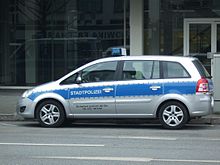
In the state of Hesse, city police forces provide the local order enforcement. The officers wear police uniforms and are armed. Similar to the municipal order enforcement units, there are different denominations:
- City Police (German: Stadtpolizei)
- Community Police (German: Kommunalpolizei)
Training[sunting | sunting sumber]
Police training is primarily the responsibility of the individual states, although the federal government provides assistance and coordination. The high level of police professionalism is attributed in large degree to the length and thoroughness of training. The situation is different in the five new states of eastern Germany. Long accustomed to a compliant society, police forces of the eastern states have to adapt to the growing numbers of far right skinheads and neo-Nazis engaged in violent hate crimes against foreign workers and refugees.
Most police recruits spend about two and a half years in the regular police academy training (Mittlerer Polizeivollzugsdienst), auxiliary Police forces, equipped with way lass rights and often not equipped with a duty-weapon, are schooled in just 12 weeks. In case of higher education (Abitur), recruits can also start off at a higher rank, comparable to Lieutenant (Rank: Polizei-/Kriminalkommissar), which they have to attend police college for and acquire a bachelor's degree.
After about six years of duty as a patrol officer, an individual with an outstanding record who does well on a highly competitive examination and started off in the regular police academy (mittlerer Polizeivollzugsdienst) can go on to two or three years at a higher police school or a college of public administration to qualify for this bachelor's degree (Aufstieg in den gehobenen Polizeivollzugsdienst). The very few candidates who qualify for the highest ranks of the police study for one year at the Federal Police Leadership Academy in Münster-Hiltrup.
Off duty carry[sunting | sunting sumber]
Depending on the certain state police regulation, German police officers may be authorized to carry their department-issued firearms while off duty. Some states allow their officers to apply for the approval to purchase a private firearm, that can be carried off-duty.[3] Further restrictions that forbid off-duty carry exist (i.e. when drinking alcohol, at public events). In their private properties, the officers are required to have a safe to store their gun while not carrying it.[4]
Women in the Police[sunting | sunting sumber]
The state police forces have had female members since the implementation of the several police forces after World War II. Initially, female officers were assigned to cases involving juveniles and women, working in plainclothes without weapons. Since the mid-1970s, female police officers have performed general police patrol duties and their proportion of total police officers is steadily rising. However, their representation in leadership positions is still relatively low.
Alert Police[sunting | sunting sumber]
The Alert Police (German: Bereitschaftspolizei / BePo), literally "Readiness or Standby Police" is available in each state for riot control, although their primary function is training police recruits. Beside this, the Federal Police maintains a Bereitschaftspolizei as well, to assist the state police forces if necessary. While the states are free to choose the equipment and to organize their police forces autonomously, the state and federal alert police units receive standardized weapons, vehicles, anti-riot gears and communications equipment from the federal government by law. An office in the Federal Ministry of Interior monitors and coordinates the deployment of the BePo units, which can be called upon to assist the police of other states in case of riots or other civil unrests.
The Alert Police is assigned to barracks where they are organized along military lines into squads, platoons, and 120- to 150-member training or standby companies. In most states, the BePo contingents consists of one 600- to 800-member battalion, but in six of the larger states they are organized into regiments.
Duties vary according to local requirements. In Hamburg, for example, the BePo patrol the subway system, assist in police raids in the red-light district, and are present at large demonstrations and soccer matches. Their units are equipped with their own transport, tents, and rations, enabling them to be shifted quickly to other Länder without having to rely on outside support. The Readiness Police have water cannons and armored vehicles but are armed with lighter weapons than those of the federal police.
All state alert police forces and the federal alert police force maintain specialized units as well, the so-called Arrest Units (German: Beweissicherungs- und Festnahmeeinheiten, lit. "Units for arrests and securing evidence", abbreviated BFE). The BFE units were established in 1987 after two police officers have been killed during demonstrations against the expansion of Frankfurt Airport.
As a reaction to several terrorist attacks in Europe since 2015, an additional unit, the BFE+, was implemented in summer 2015. The BFE+ should provide specialized operators for long lasting (search) operations for example after a terrorist attack.
Career brackets[sunting | sunting sumber]
In general, the German law enforcement authorities of today have personnel of three available career brackets, the lowest being the "Mittlerer Dienst" ("middle service"), followed by the so-called "gehobener Dienst" ("elevated service") and the "Höherer Dienst" ("higher service"). Only the Federal Customs Administration (Bundeszollverwaltung) and the Departments of Justice and Corrections of the states (Justizvollzugsdienst—Justice Enforcement Service) still have personnel of the very lowest career bracket "Einfacher Dienst" ("simple service"). To understand this structure it may be helpful to compare it with military rank structures because decades ago it was really similar. Einfacher Dienst = Soldiers, mittlerer Dienst = NCOs, gehobener Dienst = COs, höherer Dienst = Staff Officers (Major and up).
Development of career brackets[sunting | sunting sumber]
Today nine of sixteen State Police Forces recruit only for the career bracket of the "gehobener Dienst".
Entry into "Mittlerer Dienst" requires successful completion of 10 years of schooling, or a successful training in any other job and some years of working in this job. Period of training is 2 1/2 years at the police academy starting with the rank of Polizeimeister-Anwärter. The highest possible rank in this bracket is that of Polizeihauptmeister mit Zulage. In the mid to late seventies the "mittlerer Dienst" was disestablished for the detective branch Kriminalpolizei, but in some states of the former GDR, they still exist. Rank designation, in this case, f.e. Kriminalhauptmeister.
Entry into the "gehobener Dienst" requires a high-school diploma and period of training is 3 years at a college of administration and justice. The highest possible rank in this career is that of Erster Polizei-/Kriminal-hauptkommissar.
The third career bracket is the so-called "höherer Dienst". A direct entry into this career bracket is possible and requires a law degree of a university, but the majority of these officers had started their career in "mittlerer" or "gehobener Dienst". Period of training is 2 years at the Deutsche Hochschule der Polizei or German Police University. That is the only official centralised educational institution of the German police. Starting at the rank of "Polizeirat"or "Kriminalrat" (literally "police counsellor" or "detective counsellor") up to "Polizeipräsident" ("police president"), which is (in most German states) equivalent to the rank of Chief of Police in the USA.
Kehakiman[sunting | sunting sumber]
Sistem undang-undang Jerman adalah undang-undang sivil kebanyakannya berdasarkan kompilasi komprehensif undang-undang, berbanding sistem undang-undang. Bundesverfassungsgericht (Mahkamah Perlembagaan Persekutuan, yang terletak di bandar Karlsruhe) adalah Mahkamah Agung Jerman yang bertanggungjawab untuk perkara-perkara perlembagaan, dengan kuasa semakan kehakiman.[5][6] Sistem pengadilan tertinggi Jerman, yang disebut Oberste Gerichtshöfe des Bundes ("Mahkamah Agung Persekutuan Mahkamah Agung"), khusus untuk kes-kes sivil dan jenayah, mahkamah rayuan tertinggi ialah penyiasat Mahkamah Keadilan Persekutuan ("Bundesgerichtshof" di Karlsruhe) dan untuk urusan lain mahkamah adalah Mahkamah Buruh Persekutuan ("Bundesarbeitsgericht" di Erfurt), Mahkamah Sosial Persekutuan ("Bundessozialgericht" di Kassel), Mahkamah Kewangan Persekutuan Jerman ("Bundesfinanzhof" di Munich) dan Mahkamah Pentadbiran Persekutuan Jerman Mahkamah ("Bundesverwaltungsgericht" di Leipzig). Völkerstrafgesetzbuch (Kod Pidana Antarabangsa) mengatur akibat dari jenayah terhadap kemanusiaan, pembunuhan ramai-ramai dan kejahatan perang, di bawah keadaan tertentu.[7]
Undang-undang jenayah dan peribadi dikodifikasikan di peringkat kebangsaan dalam Strafgesetzbuch (secara harfiahnya Kitab Undang-undang Pidana) dan Bürgerliches Gesetzbuch (secara harfiah). Sistem hukuman Jerman ditujukan untuk pemulihan jenayah dan perlindungan orang awam.[8] Kecuali jenayah kecil, yang diadili di hadapan seorang hakim profesional tunggal, dan kejahatan politik yang serius, semua tuduhan dibicarakan sebelum tribunal campuran di mana hakim (atau Schöffe) duduk berdampingan dengan hakim profesional.[9][10]
Peralatan[sunting | sunting sumber]
Kenderaan[sunting | sunting sumber]

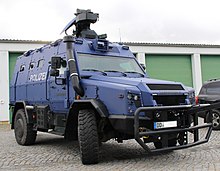


Polis Jerman biasanya menggunakan kereta dari pengeluar Jerman. Mercedes-Benz, Volkswagen, Audi, Opel dan BMW biasanya digunakan sebagai kereta ronda ( Streifenwagen ). Negara-negara digunakan untuk memilih kenderaan yang dibina di atau dekat dengan negara masing-masing. Walau bagaimanapun, dengan kebanyakan negeri sekarang menyewa dan bukannya membeli kenderaan mereka dan berdasarkan peraturan Kesatuan Eropah mengenai tawaran kontrak, negara-negara mempunyai garis lintang yang kurang dalam memilih pengeluar mana yang akan menyediakan kereta rondaan mereka daripada yang mereka lakukan.
Di Saarland yang bersejarah rapat dengan negara jiran Perancis, kenderaan dari syarikat Perancis serta Ford Eropah Eropah digunakan sebagai kereta polis. Polis Negeri Bavaria menggunakan kenderaan BMW dan Audi terutamanya syarikat yang berpangkalan di Bavaria (BMW di Munich dan Audi di Ingolstadt). Di negara bahagian timur Jerman, kebanyakannya Volkswagens sedang digunakan (Volkswagen berpangkalan di Wolfsburg, dekat dengan negara-negara timur). Polis Hessian lebih suka kereta Opel (General Motors - jenama Opel yang berpusat di Rüsselsheim berhampiran Frankfurt am Main di Hesse). Baden-Württemberg kebanyakannya menggunakan kereta Mercedes-Benz dan Volkswagen untuk pasukan polis mereka.
Sebelum pembaharuan polis pada pertengahan 1970-an, Jerman mempunyai banyak pasukan polis di bandaraya dan masing-masing mempunyai kesatuan kereta polis sendiri. Biru gelap, hijau gelap dan putih adalah warna yang popular. Walau bagaimanapun, warna-warna gelap dianggap sebagai kelemahan kerana banyak kemalangan berlaku pada waktu malam semasa mengejar kelajuan tinggi. Oleh itu, persidangan menteri-menteri pedalaman memutuskan untuk menyeragamkan hati kereta polis supaya kereta-kereta tersebut tidak terancam dan dapat dilihat dengan mudah pada waktu malam. Hijau dan putih yang terang menjadi warna yang berkaitan dengan kenderaan polis di Jerman bermula pada tahun 1970-an. Lebih baru-baru ini, pasukan polis berubah menjadi kereta dan van perak berbanding kereta putih kerana mereka lebih mudah untuk menjual daripada yang putih ketika perkhidmatan polis mereka berakhir. Sekarang, kebanyakan negara mempunyai warna biru muda dan bukan jalur hijau, tetapi kereta yang dicat di hati lama masih dapat dilihat (sehingga November 2012). Hanya negeri-negeri Bavaria dan Saarland memilih untuk mengekalkan hati hijau-putih / perak; semua negeri lain sedang beralih ke biru-putih / perak.
Hari ini, pasukan polis Jerman secara amnya menyewa kereta peronda daripada pengilang, biasanya untuk tempoh tiga tahun. Syarikat pajakan menandakan kereta rondaan menggunakan foil plastik dengan mencerminkan jalur sebagai sempadan dan bukan lukisan. Kerajang akan dikeluarkan apabila kereta dijual kepada orang ramai sebagai kereta yang digunakan perak standard apabila pajakan habis.
Tidak seperti di negara lain seperti Amerika Syarikat, kereta polis di Jerman jarang datang dengan apa-apa peralatan khas (selain dari yang jelas, seperti lampu berkelip atau sirene) tidak tersedia kepada pengguna lain model yang sama, seperti kereta yang dijual di pasaran Eropah pada umumnya dianggap sesuai untuk tugas polis tanpa sebarang perubahan lagi.

Jenis kenderaan[sunting | sunting sumber]
Kenderaan ini digunakan oleh agensi penguatkuasaan undang-undang di Jerman:
Seragam[sunting | sunting sumber]

Dari tahun 1945 dan seterusnya, pasukan polis Jerman memakai pakaian seragam berwarna yang berbeza. Dari pertengahan tahun tujuh puluhan, polis dari semua negara Jerman Barat dan Berlin Barat memakai pakaian seragam hijau dan merah yang sama, kebanyakan bahagian yang direka oleh Heinz Oestergaard. Seragam standard terdiri daripada tunik, parka, pullover tanpa kafan, mantel, topi visor dan dasi dalam lumut-hijau, seluar, pullover dan kardigan dalam coklat-kuning air, baju (lengan panjang dan pendek) di buluh-kuning. Kasut, kasut, sarung tangan, jaket kulit dan lain-lain peralatan kulit hitam. Sarung tangan kulit adalah zaitun. Terdapat beberapa pengecualian. Cap topi dengan topi putih dipakai oleh polis trafik dan oleh Schutzpolizei semasa tugas pengawalan lalu lintas.
Pasukan pasukan polis sungai atau perairan (Bahasa Jerman: Wasserschutzpolizei) memakai pakaian seragam reka bentuk yang sama sekali berbeza. Pakaian seragam asas berwarna biru laut, baju berwarna putih dan topi visor mempunyai topi putih. BGS memakai seragam hijau hutan dengan baju buluh kuning. Selepas Penyatuan semula Jerman Volkspolizei dipecah menjadi Landespolizei dan beralih kepada seragam standard. Semasa tempoh peralihan, mereka masih memakai pakaian seragam lama mereka tetapi dengan lengan gaya barat dan tanda bertanda.
Kerana kebanyakan negara Eropah mempunyai seragam polisi biru, semua negara Jerman dan Polis Persekutuan telah beralih ke pakaian seragam biru yang baru untuk menyesuaikan diri dengan imej biru yang paling banyak pasukan polis di Eropah. Sejajar dengan pakaian seragam, kenderaan polis dan pelbagai peralatan juga berubah warna dari hijau ke biru.
Lihat juga[sunting | sunting sumber]
- Senarai agensi penguatkuasaan undang-undang di Jerman
- Zollkriminalamt (Jabatan Penyiasatan Kastam Jerman)
- Staatsanwaltschaft (pejabat pendakwa raya)
- Jenayah di Jerman
- Penjara di Jerman
- Senarai pembunuhan oleh pegawai peguatkuasaan undang-undang di Jerman
Rujukan[sunting | sunting sumber]
Rencana ini mengandungi bahan daripada Perpustakaan Kongres Pengajian Negara yang merupakan terbitan pemerintah Amerika Syarikat dalam domain awam.
- ^ OSCE Entry on BPOL http://polis.osce.org/countries/details.php?item_id=17#Country_Profile_Section_211 Diarkibkan 2009-05-24 di Wayback Machine
- ^ OSCE entry http://polis.osce.org/countries/details.php?item_id=17#Country_Profile_Section_212 Diarkibkan 2009-05-24 di Wayback Machine
- ^ "Waffengesetz (WaffG) § 55 Ausnahmen für oberste Bundes- und Landesbehörden, Bundeswehr, Polizei und Zollverwaltung, erheblich gefährdete Hoheitsträger sowie Bedienstete anderer Staaten" [Weapons Act §55 Exceptions for higher federal and state authorities, military, police and customs, extensive dangered public authorities as well as servants other countries]. Error: the
dateoryearparameters are either empty or in an invalid format, please use a valid year foryear, and use DMY, MDY, MY, or Y date formats fordate(dalam bahasa Jerman). Bundestag (Federal parliament) with approval by Bundesrat (State representatives). - ^ Personal Knowledge
- ^ "Germany". U.S. Department of State. 10 November 2010. Dicapai pada 26 March 2011.
- ^ "Federal Constitutional Court". Bundesverfassungsgericht. Diarkibkan daripada yang asal pada 29 April 2011. Dicapai pada 26 March 2011.
- ^ "Völkerstrafgesetz Teil 1 Allgemeine Regelungen" (dalam bahasa German). Bundesministerium der Justiz. Dicapai pada 19 April 2011.CS1 maint: unrecognized language (link)
- ^ "§ 2 Strafvollzugsgesetz" (dalam bahasa German). Bundesministerium der Justiz. Dicapai pada 26 March 2011.CS1 maint: unrecognized language (link)
- ^ Jehle, Jörg-Martin; German Federal Ministry of Justice (2009). Criminal Justice in Germany. Forum-Verlag. m/s. 23. ISBN 978-3-936999-51-8.
- ^ Casper, Gerhard; Zeisel, Hans (January 1972). "Lay Judges in the German Criminal Courts". Journal of Legal Studies. 1 (1): 141. doi:10.1086/467481. JSTOR 724014.CS1 maint: ref=harv (link)
| Wikimedia Commons mempunyai media berkaitan BukanTeamBiasa/Kotak pasir/Penguatkuasaan undang-undang di Jerman |

